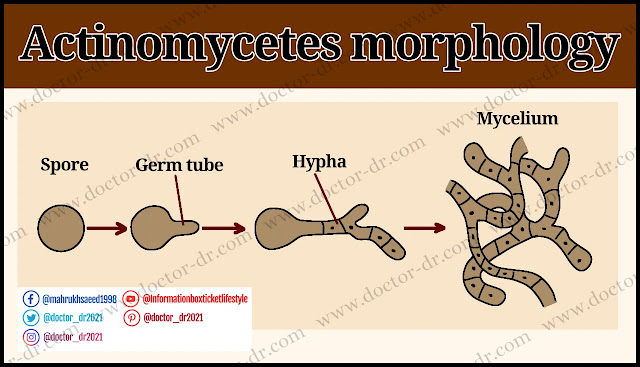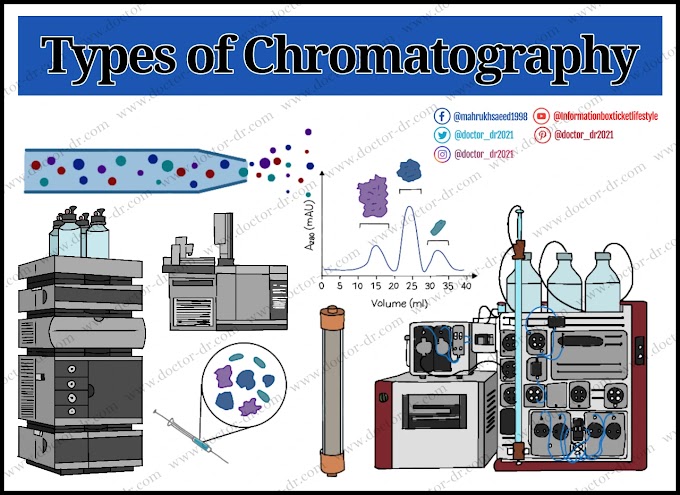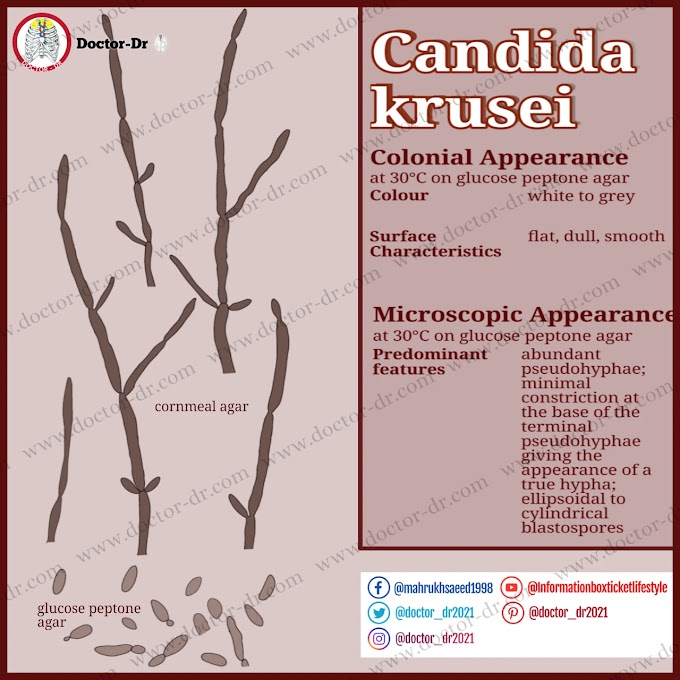Actinobacteria are spore-forming, aerobic or facultative, Gram-positive bacteria that belong to the order Actinomycetales. They are distinguished by their high DNA guanine and cytosine (G + C) content (>55 mol%) and rod-shaped or filamentous structures resembling mycelium.
From the Greek words "atkis" (a ray) and "mykes" (a fungus), "Actinomycetes" was formed. This implies that they share structural similarities with fungus, but because they are biochemically more similar to bacteria, they fall within the category of bacteria. The words "Fungus" and "Bacterium" are being linked together. Other names for them include Actinobacteria and Actinomycetota.
Table of Contents
General Characteristics of Actinobacteria
- gram-positive, rod-shaped, or filamentous in nature
- Reproduction via spore and fragmentation
- Production of substrate mycelium and aerial mycelium that resembles fungi in culture
- Pigmentation in most
- DNA has a high G+C composition (55–75%).
- Habitat ubiquitous (free-living, symbiotic, varying pH, salinity, and oxygen)
- Cell walls and filaments include mucolic acid and muramic acid.
- shorter generation time than other bacteria
- Most are non-motile
- Most don't have capsules.
Actinomycetes Life cycle
- Actinomycetes are a group of gram-positive bacteria that have a filamentous growth pattern.
- They typically live in soil and can also be found in aquatic environments.
- The life cycle of actinomycetes starts with the germination of spores that are released by the bacteria into the soil.
- Once the spores germinate, they grow into hyphae, which are long, branching filaments that form a network.
- The hyphae continue to grow and branch, forming a complex network called a mycelium.
- The mycelium can grow for years and can extend for meters through the soil.
- Under certain conditions, such as when nutrients are scarce, the mycelium forms spore-bearing structures called sporangia.
- The sporangia release spores into the environment, which can germinate to start the cycle again.
- Some actinomycetes are capable of producing antibiotics and other secondary metabolites, which are used in medicine and agriculture.
- Actinomycetes play an important role in soil ecology and are involved in nutrient cycling and organic matter decomposition.
Actinobacteria Classification
- Actinobacteria (now called Actinomycetia)
- Acidimicrobiia
- Coriobacteriia
- Nitriliruptoria
- Rubrobacteria
- Thermoleophilia
Some Common Actinobacteria Genera
|
Streptomyces |
Nocardioides |
Saccharomonospora |
|
Nocardia |
Pseudonocardia |
Saccharopolyspora |
|
Micromonospora |
Microbispora |
Saccharothrix |
|
Actinomyces |
Actinomadura |
Thermomonospora |
|
Frankia |
Micrococcus |
Mycobacterium |
|
Actinoplanes |
Rothia |
Kitasatospora |
|
Streptosporangium |
Microbacterium |
Chainia |
|
Arthrobacter |
Corynebacterium |
Dactylosporangium |
|
Salinispora |
Rhodococcus |
Proactinomyces |
|
Nonomuria |
Thermoactinomyces |
Planobispora |
|
Microtetraspora |
Actinosynnema |
Streptoalloteichus |
|
Agromyces |
Nocardiopsis |
Brevibacterium |
|
Catellatospora |
Faenia |
Habitat and Ecology of Actinobacteria
- Almost every form of soil, including desert (sandy), rocky, agricultural, vegetation-rich, fertile, and barren soil, is a component of terrestrial habitat. The majority of the soil microbiome is made up of actinobacteria, which have a microbial load of 106–108 cells per gramme of soil. Geosmin and 2-methylisoborbeol, both generated by Actinobacteria, are also responsible for the earthy odour of recently ploughed fields. The most researched actinobacteria are those found in soil, and both human and biogeochemical processes depend heavily on them.
- Streptomyces, Micromonospora, Nocardia, Pseudonocardia, Actinomadura, Mycobacterium, etc. are a few common soil actinobacteria.
- Marine and freshwater environments are both considered aquatic. Some actinobacterial taxa may be found in both highly hot (hydrothermal vent) and extremely cold (arctic water and snowy regions) environments.
- Streptomyces, Rhodococcus, Actinoplanes, Thermoactinomyces, Micromonospora, Corynebacterium, Arthrobacter, etc. are a few frequent freshwater taxa.
- Some common marine genera are Rhodococcus, Salinispora, Streptomyces, Marinophilus, Salinibacterium, Dietzia, Solwaraspora, etc.
- Extremophiles include a number of Actinobacteria species. They can withstand low temperatures (psychrophile), high temperatures (thermophile), and both low and high temperatures. Psychrophilic species include Corynebacterium psychrophilum, Modestobacter multiseptatus, Streptoverticillium spp., etc., while thermophilic species include Thermoactinomyces, Thermomonospora, Saccharopolyspora, etc.
- Acidophilic actinobacteria are those that thrive in an environment with a pH of 3 or below; examples include Streptoacidiphilus, Actinospica, Catenulispora, Streptomyces acidiphilus, and others.
- Halo-alkalophilic Actinobacteria are a rare breed and include species like Bogoriella caseilytica and Kocuria spp.
- Numerous species may be found in soil that contains a lot of salt; some even require medium with a NaCl content of close to 5 M to support their growth. Actinobacteria that are halophilic include Salinispora, Dietzia, Williamsia, Marinophilus, etc.
- Actinobacterial endophytes are also often isolated and researched. The majority of them are linked to nitrogen fixing and the rhizosphere. Endophytic actinobacteria include Frankia spp., Streptomyces spp., Streptoverticillium spp., Glycomyces spp., Plantactinospora spp., Polymorphospora spp., etc.
- There is symbiosis between many genera. They are connected to a variety of creatures, including plants, animals, and others. Many of them are common inhabitants of the epidermis, respiratory system, and stomach.
Morphology of Actinobacteria
- The Actinobacteria includes organisms with a variety of morphological characteristics. They exhibit various cellular configurations and branching.
- They are typically rod-shaped and range in length from 0.5 to 2.5 mm (some are even up to 5 mm). Others, like Micrococcus, are likewise cocci.
- Mycelial (hyphal) growth is produced by several species. Additionally, the forms of these mycelia vary. others are straight, others are twisted, some are septated, and some are aseptated.
- Several species can be distinguished by their aerial mycelium, which contains spores or other spore-forming structures. Straight, flexuous, fascicled, monoverticillate without spirals, monoverticillate with spirals, open loops, open spirals, closed spirals, and biverticillate with and without spirals are only a few of the possible characteristics of this aerial mycelia.
- Conidiospores, sporangiospores, and oidiospores, three different kinds of spores, are shown.
- Only a small number of species have fimbriae, whereas many do not. So, the majority of them are not mobile.
- Most of them exhibit dry pigmented colonies with substrate and aerial hyphae that have a cottony, velvety, or powdery look on culture. Both aerial and substrate hyphae show pigmentation. Only a few (species in capsules) can also grow wet colonies.
Actinobacteria Identification Method
- The 16S rRNA analysis technique is presently the most accurate identifying technique. Additionally, the DNA probe method and the PCR method are important molecular identification techniques.
- Identification requires a microscopic examination of the cellular structure, spore-forming structure, spores, branching pattern, and filament structure. Colony morphology, pigmentation, and biochemical traits are also used to identify the isolated species in addition to these traits.
- International Streptomyces Project (ISP) media (ISP media from ISP 1 to ISP 9) are commonly used media for the growth and study of colony characters.
- Gramme staining, the catalase test, the salt tolerance test, the oxidase test, the nitrate reduction test, the starch hydrolysis test, the casein hydrolysis test, the gelatin hydrolysis test, the urea hydrolysis test, the IMViC test, the TSI test, the sugar fermentation test, etc. are examples of common biochemical tests that are carried out.
Significance of Actinobacteria
Roles in Nature
- They play a big role in natural decomposition. Actinobacteria are necessary for the degradation of complex organic materials such cellulose, lignin, keratin, chitin, hemicellulose, and other complex polymers. Degradation promotes plant growth and improves soil fertility.
- They are crucial to the natural cycle of nutrients. They contribute significantly to the biogeochemical cycles because they are involved in the oxidation of organic materials and the incorporation of inorganic stuff.
- They can be found in severe niches and keep the biogeochemical cycle going there. They support life in such hostile environments.
- They emit a variety of enzymes, vitamins, proteins, antimicrobials, and micronutrients that have an impact on the microbial flora in soil and aquatic habitats.
Human Applications of Actinobacteria
Pharmaceutical Uses
- Antimicrobials mostly come from actinobacteria. The majority (more than two thirds) of all antibiotics are generated from Actinobacteria, particularly from Streptomyces species and Micromonospora species.
- Tetracyclines, cephamycins, macrolides (such as streptomycin, erythromycin, gentamicin, etc.), quinolones, chloramphenicol, certain aminoglycosides, some -lactams, rapamycin, etc. are a few popular antibiotics produced from Actinobacteria.
- Actinobacteria are also the source of antimicrobial substances like amphotericin, daryamides, etc., antiparasitic substances like avermectin, and anticancer substances like Adriamycin, 1,8-Dihydroxy-2-ethyl-3-methyl anthraquinone, anthracyclines, butenolides, etc.
Bioremediation and Composting
- In the bioremediation of soil contaminated with refractory organic materials, actinobacteria are frequently utilised.
- In soil that is abundant in complex organic materials and hydrocarbons, they predominate.
- Mesophilic Actinobacteria and other saprophytes first interact with organic wastes during the composting process, but when the temperature rises over 40 °C, thermophilic Actinobacteria take over and supplant other saprophytes.
- Finally, fungal species and Actinobacteria working on cellulose, hemicellulose, chitin, keratin, and other complex substances rule during the maturation period of composting.
Enzymes and Vitamins Production
- Actinobacteria generate a number of enzymes with potential uses in the fermentation and food industries, textile and fabric industries, leather business, paper and pulp industry, and other biotechnological applications.
- Chitinases, catalases, L-asparaginase, proteases, ureases, keratinases, lipases, amylase, cellulases, xylanases, and phytases are a few of the Actinobacteria that generate commercially available enzymes.
- These enzymes are produced by several bacteria, including Streptomyces spp., Nocardiopsis spp., Thermobifida spp., Actinomadura spp., etc.
- Vitamin-B12 is produced by soil Actinobacteria like Streptomyces antibioticus, S. chromogenus, etc.
Biosurfactant Production
- Many surfactants are produced by various Actinobacteria species, including Nocardiopsis and Tsukamurella species.
- There are hydrophilic and hydrophobic moieties in these biosurfactants.
- They are employed in the manufacturing of detergents, herbicides, cosmetics, antimicrobials, and other products as well as in the paper, pulp, textile, and food sectors.
- They are also used to emulsify oil and hydrocarbons for bioremediation.
Bioherbicides, Bioinsecticide, and Biolarvicide Production
- Unwanted weeds are controlled by the secondary metabolites produced by several Actinobacteria genera.
- To inhibit the growth of weeds, Streptomyces saganonensis, S. viridochromogenes, and several other Streptomyces spp. create herbimycins and herbicidines.
- Herbicides such anisomycin, bialaphos, coformycin, hydantocidin, phthoxazolin, homoalanosin, etc. are made by several Streptomyces species.
- It has been discovered that Streptomyces spp., Micropolyspora spp., and Streptosporangium spp. all generate insecticidal and larvicidal substances.
- Tetranectin, avermectins, flavonoids, and other secondary metabolites have anti-mosquito activity.
Plant Growth Hormones Production
- Plant Growth Promoting Rhizobacteria (PGPR) are Actinobacteria in soil that are linked to rhizomes.
- They aid in the digestion and intake of nourishment, create hormones that encourage plant development, and create antimicrobials that combat plant infections.
Plant Diseases and Plant Parasite Controlling Agents
- It has been discovered that the Streptomyces spp. produced avermectin and ivermectin have nematicidal effects on soil netamodes and filarial worms.
- Additionally, it has been discovered that many species of Salinispora, Marinactinospora, etc. generate antiparasitic substances.
- Actinobacteria like Streptomyces spp., Micromonospora spp., Streptoverticillium spp. generate agroactive chemicals like antibiotics and antifungals against plant infections like Rhizoctonia spp., Pseudomonas spp., Pyricularia oryzae, etc.
- Actinobacteria generate medicines for treating plant diseases, such as fungichromin, validamycin, nigericin, faerifungin, and geldanamycin.
Nanoparticle Synthesis
- For the creation of nanoparticles with medicinal characteristics, certain Actinobacteria are crucial sources.
- Streptomyces species, Nocardiopsis species, Actinopolyspora species, Actinomadura species, etc. are significant species that produce silver nanoparticles.
- It has also been discovered that Streptomyces species create nanoparticles of gold, zinc, copper, and magnesium.
Pigment Production
- Actinobacteria may produce a wide range of colours, which are typically tints of blue, violet, red, yellow, pink, green, black, and brown.
- Actinobacteria like Streptomyces spp. and Synodontis violaccus are utilised in the commercial manufacturing of a few pigments like rhodomycin, actinomycin, granaticin, and a few prodigiosin even though the majority of industrially used colours are made chemically.
Harmful Effects
Plant Diseases
|
Actinobacteria Species
Associated |
Disease Caused |
|
Corynebacterium betac, C.
flaccumfaciens, C. insidiosum, C. nebraskense, C. sepedonicum |
Wilt diseases of the bean, red
beet, alfalfa, corn, potato, etc. |
|
C. michiganense |
Tomato root canker |
|
C. oortii |
Spot disease of tulip leaves and
bulb |
|
Rhodococcus fascians |
Leaf gall disease |
|
Nocardia vaccinii |
The proliferation of gall and
bud in blueberry |
|
Streptomyces aureofaciens, S. griscus, S.
flavcolus, |
Scab of potato and sweet potato |
|
Arthrobacter ilicus |
Blight disease of Ilex
opaca |
Human Diseases
|
Actinobacteria Species Associated |
Disease Caused |
|
Mycobacterium tuberculosis complex |
Tuberculosis |
|
Mycobacterium leprae |
Leprosy |
|
Corynebacterium diphtheriae |
Diphtheria |
|
Actinomyces bovis, A. israelii |
Actinomycosis |
|
A. madura, Nocardia asteroides,
Streptomyces somaliensis, Nippostrongylus spp. |
Actinomycetoma |
|
Rothia dentocariosa, Oerskovia turbata |
Endocarditis |
|
Nocardia asteroides, N. brasiliensis,
N. dassonvillei |
Nocardiosis |





~1.webp)

.webp)


